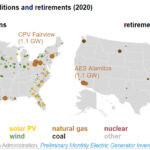
California was the largest net electricity importer of any state in 2019
EIA Electricity routinely flows between the Lower 48 states and, to a lesser extent, between the United States and Canada and Mexico. Electricity generation exceeds electricity consumption in 25 states, and excess electricity is transmitted across state lines—almost 10% of U.S. electricity generation is traded among states. In 2019, California’s net electricity imports were the largest in the country at 70.8 million




